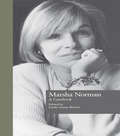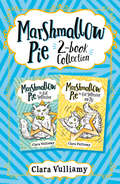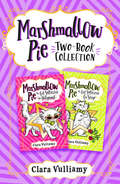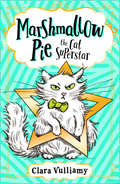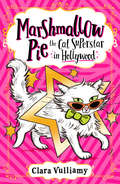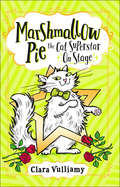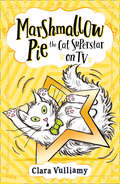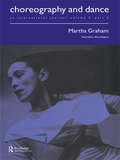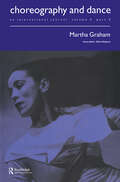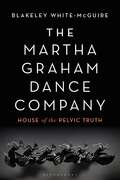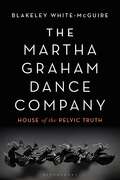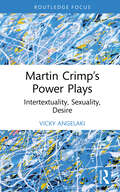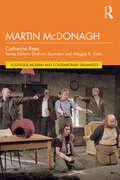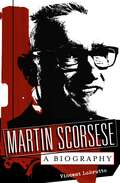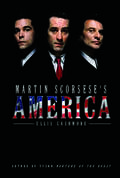- Table View
- List View
Marsha Norman: A Casebook (Casebooks on Modern Dramatists #Vol. 19)
by Linda Ginter BrownFirst Published in 1996. Routledge is an imprint of Taylor & Francis, an informa company.
Marsha Norman: A Casebook (Casebooks on Modern Dramatists)
by Linda Ginter-BrownFirst Published in 1996. Routledge is an imprint of Taylor & Francis, an informa company.
Marshmallow Pie 2-book Collection, Volume 1: Marshmallow Pie The Cat Superstar, Marshmallow Pie The Cat Superstar On Tv
by Clara VulliamyA hilarious new series from Clara Vulliamy, the author-illustrator of Dotty Detective, about grumpy cat Marshmallow Pie and his reluctant pursuit of stardom. Perfect for fans of Toto the Ninja Cat or The Secret Life of Pets.
Marshmallow Pie 2-book Collection, Volume 2: Marshmallow Pie The Cat Superstar In Hollywood, Marshmallow Pie The Cat Superstar On Stage
by Clara VulliamyBooks 3 and 4 in a hilarious new series from Clara Vulliamy, the author-illustrator of Dotty Detective, about grumpy cat Marshmallow Pie and his reluctant pursuit of stardom. Perfect for fans of Toto the Ninja Cat or The Secret Life of Pets.
Marshmallow Pie The Cat Superstar: The Cat Superstar (Marshmallow Pie Ser. #01)
by Clara VulliamyA hilarious new series from Clara Vulliamy, the author-illustrator of Dotty Detective, about grumpy cat Marshmallow Pie and his reluctant pursuit of stardom. Perfect for fans of Toto the Ninja Cat or The Secret Life of Pets.
Marshmallow Pie The Cat Superstar in Hollywood (Marshmallow Pie the Cat Superstar #3)
by Clara VulliamyThe third book in the Marshmallow Pie the Cat Superstar series by Clara Vulliamy, the author-illustrator of Dotty Detective.
Marshmallow Pie The Cat Superstar On Stage (Marshmallow Pie the Cat Superstar #4)
by Clara VulliamyThe fourth book in the Marshmallow Pie the Cat Superstar series by Clara Vulliamy, the author-illustrator of Dotty Detective
Marshmallow Pie The Cat Superstar On TV (Marshmallow Pie Ser. #02)
by Clara VulliamyThe second book in the Marshmallow Pie Cat Superstar series by Clara Vulliamy, the author-illustrator of Dotty Detective. Perfect for fans of Toto the Ninja Cat or The Secret Life of Pets.
Martha Graham: A special issue of the journal Choreography and Dance
by Alice HelpernFirst Published in 1999. Routledge is an imprint of Taylor & Francis, an informa company.
Martha Graham: A special issue of the journal Choreography and Dance
by Alice HelpernFirst Published in 1999. Routledge is an imprint of Taylor & Francis, an informa company.
The Martha Graham Dance Company: House of the Pelvic Truth
by Blakeley White-McGuireWhat is the legacy of Martha Graham and why does it endure?How and why did the philosophy and subsequent canon of Martha Graham flood out into an artistic diaspora that is still a wellspring of inspiration for contemporary artists?How do dancers that have never studied with, or worked under, Martha Graham maintain her vision?All of these questions, and many more, are considered in this fascinating book, authored by one of the Martha Graham Company's ex-principal dancers, which illuminates the ongoing significance of the Martha Graham Dance Company almost 100 years after it was founded. Through doing so, we are offered a study of the history of the Martha Graham Dance Company - the longest-standing modern dance company in America, its international diaspora and the current generation of dancers taking up the mantel. Drawing on extensive interviews conducted for the book, the company's story is told through the experiences, inspirations, motivations and words of performers from Graham's iconic artistic lineage.
The Martha Graham Dance Company: House of the Pelvic Truth
by Blakeley White-McGuireWhat is the legacy of Martha Graham and why does it endure?How and why did the philosophy and subsequent canon of Martha Graham flood out into an artistic diaspora that is still a wellspring of inspiration for contemporary artists?How do dancers that have never studied with, or worked under, Martha Graham maintain her vision?All of these questions, and many more, are considered in this fascinating book, authored by one of the Martha Graham Company's ex-principal dancers, which illuminates the ongoing significance of the Martha Graham Dance Company almost 100 years after it was founded. Through doing so, we are offered a study of the history of the Martha Graham Dance Company - the longest-standing modern dance company in America, its international diaspora and the current generation of dancers taking up the mantel. Drawing on extensive interviews conducted for the book, the company's story is told through the experiences, inspirations, motivations and words of performers from Graham's iconic artistic lineage.
Martha Graham in Love and War: The Life in the Work
by Mark FrankoOften called the Picasso, Stravinsky, or Frank Lloyd Wright of the dance world, Martha Graham revolutionized ballet stages across the globe. Using newly discovered archival sources, award-winning choreographer and dance historian Mark Franko reframes Graham's most famous creations, those from the World War II era, by restoring their rich historical and personal context. Graham matured as an artist during the global crisis of fascism, the conflict of World War II, and the post-war period that ushered in the Cold War. Franko focuses on four of her most powerful works, American Document (1938), Appalachian Spring (1944), Night Journey (1948), and Voyage (1953), tracing their connections to Graham's intense feelings of anti-fascism and her fascination with psychoanalysis. Moreover, Franko explores Graham's intense personal and professional bond with dancer and choreographer Erick Hawkins. The author traces the impact of their constantly changing feelings about each other and about their work, and how Graham wove together strands of love, passion, politics, and myth to create a unique and iconically American school of choreography and dance.
Martha Graham in Love and War: The Life in the Work
by Mark FrankoOften called the Picasso, Stravinsky, or Frank Lloyd Wright of the dance world, Martha Graham revolutionized ballet stages across the globe. Using newly discovered archival sources, award-winning choreographer and dance historian Mark Franko reframes Graham's most famous creations, those from the World War II era, by restoring their rich historical and personal context. Graham matured as an artist during the global crisis of fascism, the conflict of World War II, and the post-war period that ushered in the Cold War. Franko focuses on four of her most powerful works, American Document (1938), Appalachian Spring (1944), Night Journey (1948), and Voyage (1953), tracing their connections to Graham's intense feelings of anti-fascism and her fascination with psychoanalysis. Moreover, Franko explores Graham's intense personal and professional bond with dancer and choreographer Erick Hawkins. The author traces the impact of their constantly changing feelings about each other and about their work, and how Graham wove together strands of love, passion, politics, and myth to create a unique and iconically American school of choreography and dance.
Martha Graham's Cold War: The Dance of American Diplomacy
by Victoria PhillipsMartha Graham's Cold War frames the story of Martha Graham and her particular brand of dance modernism as pro-Western Cold War propaganda used by the United States government to promote American democracy. Representing every seated president from Dwight D. Eisenhower through Ronald Reagan, Graham performed politics in the global field for over thirty years. Why did the State Department consistently choose Martha Graham? As with other art forms such as jazz or avant-garde paintings, modern dance was seen to demonstrate American values of individualism and freedom; the choreographer used the freed body to make a new dance technique that could find the essence of human narratives. Graham targeted elites and its youth with modern dance to propound the 'universalism' of human rights under the banner of American democracy. In her choreography, argues author Victoria Phillips, Graham recast the stories of the Western canon through female protagonists whom she captured as timeless, seemingly beyond current politics, and in so doing implied superior political and cultural values of the Free World. Centering on powerful yet not demonstrably American female characters, the stories Graham danced seduced and captured the imaginations of elite audiences without seeming to force a determinedly American agenda. When her characters grew mythic on stage, they became the stories of all mankind, as Graham termed it. "My dances are ages old in meaning," she declared. But Graham took the pro-American argument one step further than her artistic compatriots. She added the trope of the frontier to her repertory. In the Cold War, Graham's particular modernism and the woman herself ossified, as did political aims of a cultural diplomacy based on an appeal to foreign elites. Phillips lays bare the side-by-side trajectories between the aging of Graham's choreography, her work as an ambassador, and the political dominance of the United States as a global power. With her tours and Cold War modernism, she demonstrated the power of the individual, immigrants, republicanism, and freedom from walls and metaphorical fences through cultural diplomacy with the unfettered language of movement and dance.
Martha Graham's Cold War: The Dance of American Diplomacy
by Victoria PhillipsMartha Graham's Cold War frames the story of Martha Graham and her particular brand of dance modernism as pro-Western Cold War propaganda used by the United States government to promote American democracy. Representing every seated president from Dwight D. Eisenhower through Ronald Reagan, Graham performed politics in the global field for over thirty years. Why did the State Department consistently choose Martha Graham? As with other art forms such as jazz or avant-garde paintings, modern dance was seen to demonstrate American values of individualism and freedom; the choreographer used the freed body to make a new dance technique that could find the essence of human narratives. Graham targeted elites and its youth with modern dance to propound the 'universalism' of human rights under the banner of American democracy. In her choreography, argues author Victoria Phillips, Graham recast the stories of the Western canon through female protagonists whom she captured as timeless, seemingly beyond current politics, and in so doing implied superior political and cultural values of the Free World. Centering on powerful yet not demonstrably American female characters, the stories Graham danced seduced and captured the imaginations of elite audiences without seeming to force a determinedly American agenda. When her characters grew mythic on stage, they became the stories of all mankind, as Graham termed it. "My dances are ages old in meaning," she declared. But Graham took the pro-American argument one step further than her artistic compatriots. She added the trope of the frontier to her repertory. In the Cold War, Graham's particular modernism and the woman herself ossified, as did political aims of a cultural diplomacy based on an appeal to foreign elites. Phillips lays bare the side-by-side trajectories between the aging of Graham's choreography, her work as an ambassador, and the political dominance of the United States as a global power. With her tours and Cold War modernism, she demonstrated the power of the individual, immigrants, republicanism, and freedom from walls and metaphorical fences through cultural diplomacy with the unfettered language of movement and dance.
Martin Crimp’s Power Plays: Intertextuality, Sexuality, Desire (Routledge Advances in Theatre & Performance Studies)
by Vicky AngelakiThis book covers playwright Martin Crimp’s recent work showing how it captures the nuances in our interpersonal contemporary experience. Examining the bold and exciting body of writing by Crimp, the book delves into his depiction of intersections between narratives, as well as between private and public, through an honest look at power structures and shifts, marriages and relationships, sexuality, and desire. This book will be of great interest to students and scholars in Drama, Theatre and Performance, English Literature, and Opera Studies.
Martin Crimp’s Power Plays: Intertextuality, Sexuality, Desire (Routledge Advances in Theatre & Performance Studies)
by Vicky AngelakiThis book covers playwright Martin Crimp’s recent work showing how it captures the nuances in our interpersonal contemporary experience. Examining the bold and exciting body of writing by Crimp, the book delves into his depiction of intersections between narratives, as well as between private and public, through an honest look at power structures and shifts, marriages and relationships, sexuality, and desire. This book will be of great interest to students and scholars in Drama, Theatre and Performance, English Literature, and Opera Studies.
Martin McDonagh (Routledge Modern and Contemporary Dramatists)
by Catherine ReesThis comprehensive, accessible introduction to one of Britain’s leading contemporary playwrights and filmmakers outlines Martin McDonagh’s body of work, the key critical contexts for understanding and exploring his career, analysis of productions, and includes an exclusive interview with the director of his most recent stage work. Analysis of McDonagh’s writing is broken down into three periods – his early Irish plays, his screenplays, and his later plays that move away from and outside of Ireland. Works are discussed thematically, giving a dynamic reading of the scripts and the ideas around which they circle. The book’s final section then delves in more detail into selected seminal productions of McDonagh’s writing, outlining key phases and transitions in his career.Part of the Routledge Modern and Contemporary Dramatists series, Martin McDonagh is an essential guide for scholars and students who are setting out to understand the life and work of one of the most popular and acclaimed British dramatists and filmmakers of the twenty-first century.
Martin McDonagh (Routledge Modern and Contemporary Dramatists)
by Catherine ReesThis comprehensive, accessible introduction to one of Britain’s leading contemporary playwrights and filmmakers outlines Martin McDonagh’s body of work, the key critical contexts for understanding and exploring his career, analysis of productions, and includes an exclusive interview with the director of his most recent stage work. Analysis of McDonagh’s writing is broken down into three periods – his early Irish plays, his screenplays, and his later plays that move away from and outside of Ireland. Works are discussed thematically, giving a dynamic reading of the scripts and the ideas around which they circle. The book’s final section then delves in more detail into selected seminal productions of McDonagh’s writing, outlining key phases and transitions in his career.Part of the Routledge Modern and Contemporary Dramatists series, Martin McDonagh is an essential guide for scholars and students who are setting out to understand the life and work of one of the most popular and acclaimed British dramatists and filmmakers of the twenty-first century.
Martin Scorsese: A Journey
by Mary Pat KellyIn time for Scorsese&’s 80th birthday and the release of Killers of the Flower Moon, a new edition of the seminal oral history tracing Scorsese&’s journey from young filmmaker to legend, featuring a foreword by Steven Spielberg Few filmmakers, if any, make the kind of impact that Martin Scorsese has made on American cinema. The winner of every prestigious film award, including the Oscar, Scorsese is a living legend. Bestselling author and award-winning filmmaker Mary Pat Kelly&’s groundbreaking biography reveals how this working-class boy from Manhattan&’s Little Italy became one of our most acclaimed, celebrated, and influential filmmakers.Martin Scorsese: A Journey maps Scorsese&’s personal and artistic evolution though his films, from early works like student films and Mean Streets through cinematic masterpieces like Taxi Driver, Raging Bull,The King of Comedy,Goodfellas. Across interviews with Scorsese himself; stars like Robert De Niro, Paul Newman, Liza Minelli, and Nick Nolte; colleagues including screenwriters and cinematographers; as well as family and friends, it reveals the story of a man in a way that only his community and fellow artists can, giving us unprecedented, intimate access to the making of these iconic films and the extraordinary mind behind them. Brimming with insight into Scorsese&’s life, values, process, humor, and inspirations, it is a remarkable account of America&’s premiere director, the shepherd of countless imaginations.
Martin Scorsese: A Biography
by Vincent LoBruttoMartin Scorsese's current position in the international film community is unrivaled, and his name has become synonymous with the highest standards of filmmaking excellence. He is widely considered America's best living film director, and his Taxi Driver and Raging Bull appear frequently on worldwide surveys of the best films of all time. Here, in the first biographical account of this artist's life, Vincent LoBrutto traces Scorsese's Italian-American heritage, his strict Catholic upbringing, the continuing role of religion in his life and art, his obsessive love of cinema history, and the powerful impact that the streets of New York City had on his personal life and his professional career. Meanwhile, the filmmaker's humble, soft-spoken public persona tells only part of the story, and LoBrutto will delve into the other side of a complex and often tortured personality. Scorsese's intense passion, his private relationships, his stormy marriages, and his battles with drugs and depression are all chronicled here, and, in many cases, for the first time. In addition, the book includes an interview with the director, as well as filmographies cataloging his work as a director, producer, actor, and presenter.As his Best Director award at the 2007 Oscars clearly demonstrated, Scorsese has become something like Hollywood royalty in recent years, finally enjoying the insider status and favor that eluded him for most of his career. But these recent developments aside, Scorsese is also notable as a distinctly American type of artist, one whose work-created in a medium largely controlled by commercialism and marketing-has always been unmistakably his own, and who thus remains a touchstone of artistic integrity in American cinema. In Martin Scorsese: A Biography, readers can examine not only the work of one of the form's genuine artists, but also the forces that have propelled the man behind it.
Martin Scorsese in 10 Scenes: The Stories Behind The Key Moments Of Cinematic Genius
by Tim GriersonMartin Scorsese in Ten Scenes takes an intriguing look at the life’s work of one of the world’s greatest filmmakers. Boiling down the Oscar-winner’s career to ten indelible scenes, this beautiful, full color collection examines Scorsese’s trademark techniques while offering critical analysis, filmmaking tips, and firsthand accounts from the cast and crew. An essential read for filmmakers, film students, and movie fans, this engaging and accessible book makes use of previously unreleased, behind-the-scenes material to present a multi-faceted view of each scene. With selections from Raging Bull, The King of Comedy, Goodfellas, and The Departed, Martin Scorsese in Ten Scenes provides an insightful, inspiring examination of a man whose films have influenced generations of moviegoers and filmmakers.
Martin Scorsese in 10 Scenes
by Tim GriersonMartin Scorsese in Ten Scenes takes an intriguing look at the life’s work of one of the world’s greatest filmmakers. Boiling down the Oscar-winner’s career to ten indelible scenes, this beautiful, full color collection examines Scorsese’s trademark techniques while offering critical analysis, filmmaking tips, and firsthand accounts from the cast and crew. An essential read for filmmakers, film students, and movie fans, this engaging and accessible book makes use of previously unreleased, behind-the-scenes material to present a multi-faceted view of each scene. With selections from Raging Bull, The King of Comedy, Goodfellas, and The Departed, Martin Scorsese in Ten Scenes provides an insightful, inspiring examination of a man whose films have influenced generations of moviegoers and filmmakers.
Martin Scorsese's America (America Through the Lens)
by Ellis CashmoreFor over four decades, Martin Scorsese has been the chronicler of an obsessive society, where material possessions and physical comfort are valued, where the pursuit of individual improvement is rewarded and where male prerogative is respected and preserved. Scorsese has often described his films as sociology and he has a point: his storytelling condenses complex information into comprehensible narratives about society. In this sense, he has been a guide through a dark world of nineteenth century crypto-fascism to a fetishistic twentieth century in which goods, fame, money and power are held to have magical power. Author of Tyson: Nurture of the Beast and Beckham, Ellis Cashmore turns his attention to arguably the most influential living film- maker to explore how Scorsese envisions America. Greed, manhood, the city and romantic love feature on Scorsese's landscape of secular materialism. They are among the themes Cashmore argues have driven and inform Scorsese's work. This is America, as seen through the eyes of Martin Scorsese and it is a deeply unpleasant place. Cashmore's book discloses how, collectively, Scorsese's films present an image of America. It's an image assembled from the perspectives of obsessive people, whether burned-out paramedics, compulsive entrepreneurs, tortured lovers, or celebrity-fixated comedians. It's collected from pool halls, taxicabs, boxing rings and jazz clubs. It's an image that's specific, yet ubiquitous. It is Martin Scorsese's America.
